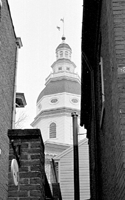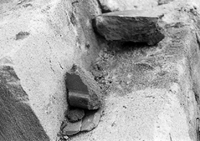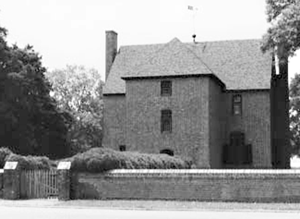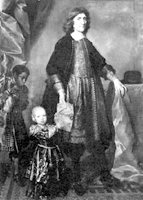 St. Mary's
St. Mary'sBlack helicopters lasso
and Lift Capitol to  St. Mary's
St. Mary's
A New Bay Times Exclusive Investigative Report
by Mark Burns
Done in the dark of night
Sen. President Mike Miller, a Southern Marylander, rejoices
AA Co. Exec. Owens sees open-space benefits
"Finders, keepers," says St. Mary's City
ANNAPOLIS, Maryland-In a startling overnight theft, the State House has been lifted from its home on State Circle in Annapolis sometime in the early morning hours of April 1.
Tethered to 16 cables strung from a swarm of black payload helicopters, the iconographic dome of the 227-year-old capitol and every story underneath was heaved from its foundation and airlifted east to the Bay, where it was loaded onto a barge and shipped south.
The absence of the picturesque capitol dome from the skyline of Annapolis has already shocked and confused many of the city's denizens, some of whom were awakened late at night by the dull roar of helicopter rotors. A few night owls even caught a glimpse of the bizarre theft.
"I was just minding my own business, crossing Francis Street on my way up Main to Church Circle," says an eyewitness who asked to be identified only as Joe. He was walking the streets of Annapolis after downing a pint at O'Brien's. "Suddenly," Joe said, "this little shard of brick knocked me on the noggin. At first I figured it was some punk kid pelting pedestrians, but when I looked around nobody was there."
Then he looked up.

"I'll be darned if it wasn't the most befuddling thing I've ever seen."
What 'Joe' saw was a cloud - a "big, dark cumulus" - crossing swiftly through the night sky, accompanied by several smaller puffs keeping the same pace. When it crossed the moon he saw an unsettling silhouette.
"Call me a loon, but that cloud was shaped a lot like the State House," says Joe, whose vision was still blurred at the time of the sighting from his encounter with hard-baked clay.
Legislation in the Sky
It only takes one glance across State Circle to realize Joe's story is no addled rumor.
Upon hearing first word of the theft - called into our Deale office by our alert Annapolitan general manager moments after the lift-off- New Bay Times assembled a massive team of editors, interns and reporters (four people) to excavate the truth on this unfolding story. After exhaustive investigation of eyewitness accounts, interrogations of public officials and a tip phoned in by an archaeologist in Historic St. Mary's City we are able to bring you the shocking details.
The State House's harrowing journey started a half-day earlier, when
conspicuous workers under the guise of building inspectors entered the capital.
Their real task: casing the State House for the best points to hook cables
into the structure. They also loosened the capital from sections of its
foundation.
Several hours later, under the veil of darkness, darkly cloaked operatives on the ground fastened cables at key points along the base, allowing the entourage of helicopters to hoist the capital. Flown at a low elevation of 500 feet, to avoid interfering with air travel lanes leading in and out of Baltimore Washington International Airport, the helicopters sped away to rendezvous with the barge, loaded the loot and stole away to St. Mary's River, delivering the State House just as the first few rays of daylight glowed on the horizon.
Now the house of legislation rests on trailer blocks in a vacant field near downtown St. Mary's City, waiting for a new foundation to be dug out in a prominent predetermined location - as of yet unrevealed by local officials but known to be within the boundaries of Historic St. Mary's City.
Broken bricks and debris are all that's left of the Capitol at State Circle in Annapolis.
History Chases its Tail
You want motive? St. Mary's City has plenty.
"People down here think the capital should never have been moved," says Karin Stanford, spokeswoman for Historic St. Mary's City. "We're looking forward to having it back where it belongs."
Though the tactics might seem a little rude, St. Mary's City's isn't the first to violate that particular sense of pride that comes with being the city. St. Mary's was victimized the first time, back in 1694, when a bunch of imported Virginian Puritans living in Anne Arundel County wrested the prideful title of State Capitol from St. Mary's City, an enclave of Catholics and favorite burg of Maryland's long-distance colonial ruler, Cecil Calvert.
The English Civil Wars of the 1640s had far-reaching effects, with radical pious politicism fueling the burgeoning power struggle here in Maryland. Puritans and Parliamentarians fought against the Catholics and Royalists here as in the mother country.
In a grand twist of irony, the power-hungry Puritans of Maryland were rescued from the religiously intolerant colony of Virginia by Maryland's Calverts to win the favor of the prevailing powers in England. The Puritans, who had already plundered St. Mary's City, got much more ornery when the Calverts, emboldened by a Catholic resurgence at home, tried to bully the Arundelites into submission with their militia from St. Mary's City - 1655's Battle of the Severn. Thus the Puritans thought it just to humiliate the Calverts' forces and step up the power struggle.
From there it snowballed, and after generations of social upheaval the Anne Arundel Puritans tore away the delicious title from St. Mary's City in 1694, bringing an era of prosperity to Annapolis and leaving St. Mary's City to whither into history.
But now, like a phoenix from the ashes, St. Mary's City has taken the first step in reclaiming its old glory. And it seems they've been empowered by the favor of key movers and shakers.
"After more than 300 years in temporary quarters, it's good to be back home in the Mother County," said President of the Senate Thomas V. Mike Miller, who's all for the migration of the State House.
Steal it Back! Or Not
It stands to reason that, as more people discover for themselves that something is indeed amiss, few will share Sen. Miller's sentiments. Reaction so far is mixed, but most demand an answer: What shall be done to rectify this ugly snub?
Annapolis Mayor Dean Johnson has revealed no retrieval tactics, though he's clear in his disdain for the theft. "I don't think this move has been approved by the Historic Preservation Commission, and I expect it to be returned as soon as possible until such permission is granted," he said.
Prideful Annapolitans may want to step lightly, though. The St. Maries Citty Militia may yet muster to defend the town's reasserted claim to status. "They didn't do such a great job last time," allowed Stanford. "It was pretty much a bloodless coup in 1689 [when the Calverts were ousted by William of Orange and replaced by an appointed governor, clearing the way for the eventual move of the capital in 1694]. However, if attacked, we will retaliate."
Mustering might already be a moot point. In fact, most of the people we interviewed are happy about the change. Some are downright flippant.
"Everybody always knew that dome was full of hot air, and now it's gone and floated away," said Jeff Holland, head of Annapolis and Anne Arundel County's Celebration 350 shindig.
Holland noted a silver lining to that dark, mysterious cloud spotted by Joe. "It's probably a good opportunity to redesign the historic district," he said.
"Everybody's been upset with Sir Francis Nicholson ever since he laid out the city in a Baroque pattern, because nobody can find a parking space. Now with one less circle, we can lay out the streets the way he should have to begin with."
Holland was confident that the State House's obvious absence will not dampen the spirits of this year's 350th anniversary celebration, despite impending complications. "The State House is one of the sites in the Passport to History," said Holland of the special upcoming tour in Annapolis' historic downtown. "Now we'll just use Leon's Barbershop as our Visiting Passport site."
Why Leon's Barbershop? Because, in a gracious gesture toward the city and state it seceded from, the Maritime Republic of Eastport has offered the use of its barbershop/seat of government to Maryland legislators. "There's plenty of room for the legislature in our capital," says Holland, who is also the Republic's minister of propaganda. "Leon only uses one of his three barber chairs. So they're welcome to come over and use ours." Besides, he said, "There's been as many great arguments hashed out there over the years as there have at the State House."
Eastport's offer, however tempting, may go untaken. If Sen. Miller is any indication, legislators may welcome the change of scenery. "Returning the to St. Mary's City gives all Marylanders an opportunity to see for themselves the beauty of Southern Maryland that our first settlers ecstatically observed when sailing up the St. Mary's River more than three centuries ago," Miller said. "It will immediately become obvious why St. Mary's was chosen to serve as the seat of government until stolen away by the citizens of Anne Arundel in 1694. Not only has history been righted, but St. Mary's can soon begin reaping the economic benefit that comes hand in hand with hosting the General Assembly during the annual legislative session."
So the Mother County once again sits cozy in the catbird seat. But what of Anne Arundel? Now that Annapolis has been reduced from the double-duty of its halcyon days to a simple county seat, will its fortunes sour?
Anne Arundel County Executive Janet Owens thinks not. In fact, the capital's removal fits in well with the county's master plan. "This administration has promised citizens of this county more open space," she said. "We're living up to our promise. With the Capitol not there you can see all the way to O'Brien's."
Aftermath of Upheaval
St. Mary's has tasted sweet revenge. There's also emerging speculation that the move might spark a few descendants from the Calvert lineage to reassert provincial claims to Maryland. Stanford could not confirm the speculations. "When we opened the lead coffins a few years ago, a few Calverts came forward to offer DNA samples," she says, "but no one has stepped forward to make any claims yet."
How long the victory will last and what fallout it will create is uncertain. Will community pressure on the powers that be bring the capital back to Anne Arundel? Or is something sinister afoot? Time will tell.
"All I know," said eyewitness Joe, "is that my head still hurts."
So you slept through Maryland history in elementary school? Here's your second chance ...
by Don Kehne
Seventeenth-century rivalries never got so bad in Maryland as in England. There, religious and political partisanship killed a king. Here, it simply uprooted a capital. But in the 17th century, Maryland was certainly an England in miniature, beset with all its turmoil and troubles.
For much of that century in England, Puritan "Roundheads" and royalist "Cavaliers" vied for supremacy in a succession of civil wars that ended bloodily as a king, Charles I, lost his head. In that era of colonization, settlers brought their troubles with them to the New World.
Which is how Annapolis came to be the capital of Maryland.
Before we tell the story, we'd better introduce the players - for which we need a wide screen.
A Troubled Old World 
Once the capitol was moved to Annapolis, the
colony at St. Mary's disappeared. Today, only reconstructions, like this,
let us imagine the original capitol.
Europe's 17th century was as bloody as its 20th. Behind much of the trouble was religion. Of course, political power went hand in hand with religious authority.
On the continent, the religious Reformation started by Martin Luther, John Calvin and other Protestant leaders a half century before had sparked a war that raged for three decades. German Protestants fought German Catholics, and France, Sweden and Denmark took on political rivals in Spain. When the Thirty Years War ended in 1648, Protestants had broken the Church of Rome's control over Central Europe. Dynasties had fallen, and all over Europe the political deck was reshuffled.
In England as well, religious wars splintered the country into competing factions. Under King Henry VIII and his daughter Queen Elizabeth, the Church of Rome had given way to the Church of England. Puritans liked neither side.
Those independent thinkers sought recognition of their right to worship as they saw fit, controlling their churches locally without pope or king. Poked fun at as Roundheads for their bowl haircuts in an age of wigs, they were outlawed as subversives. No wonder: they wanted not only churches free of painted saints but also government free of authoritarian kings.
After nearly 50 years of political maneuvering and ugly civil strife, the Protestants and Parliamentarians won out, upending the old order both in the old country and the new. Rule by divine right of kings was dead; rule by an empowered middle class was born.
Old-World Troubles in the New
The New World's population grew with settlers hoping to escape civil strife in England. When times got bad, some Puritans packed up for the Netherlands, and from there, sailed for the New World - where one group, aiming for Virginia, ended up at a place now known as Plymouth Rock.
Other Protestants found haven in Maryland, a colony founded by a Roman Catholic loyal to a Protestant English king but promising freedom of religion to all.
George Calvert, a close advisor to King James I, had given up public office in England to pursue lucrative ventures in the New World. Calvert had successfully lobbied his sovereign for land grants: first in Newfoundland, then - when the climate proved too inhospitable for a fragile new colony to take root - in the Chesapeake region, just north of the Virginia colony. As a Roman Catholic unwilling to acknowledge the supreme authority of the Anglican Church and a wealthy Cavalier with interests at home and in the New World, Calvert was suspect in the eyes of both the Puritans in England and Anglican settlers in Virginia.
If his colony prospered, Calvert - who had been rewarded with the hereditary title of Lord Baltimore for service to his king - and his family would become richer still. As Lord Proprietor, Calvert answered only to the crown. Otherwise he was free to rule Maryland much like the king ruled England. He owned all the territory within the Charter, established law and ran the church. He could also collect fees and rent from the settlers, and he could reward supporters with grants of land just as a king might - and did.
George Calvert died before his dream of a Chesapeake charter was realized,
as did King James I. But Calvert's eldest son sealed the deal with a sweetener,
promising to name the new colony in honor of King Charles I's wife, Henrietta
Marie. In 1632, King Charles granted the charter to Cecil Calvert, the second
Lord Baltimore.
Cecil Calvert, the second Lord Baltimore, with his grandson Cecil Calvert II.
In 1634,140 colonists - including a handful of Catholic gentry and over 100 Protestant commoners - sailed to Maryland. Most new arrivals came as indentured servants, laboring four or five years for their master to pay off their contract. Once freed, some servants became small planters, eventually rising to hold prominent posts in government.
Lord Baltimore remained home but sent along instructions to recreate English life in the New World, starting with a town. Cecil enlisted his brother, Leonard, to act as provincial governor. In the New World, the colonists named their land grant Terra Maria - which in the spirit of the times would become Maryland - visited St. Clement's Island and established a settlement they named St. Mary's City.
Lords and laborers weren't the only ones eyeing America for a fresh start. Strong-willed Protestant settlers came to the colony under the promise of protection from Catholic Lord Baltimore. But they soon turned on him. Following the lead of Parliament in England, Protestants, especially feisty Puritan settlers on the Severn River, pushed for common law over inherited rights.
Bringing their victory in England home to Maryland, Puritans yanked the colonial capital out of Calvert's domain at St. Mary's City and replanted it in the Puritan stronghold of Anne Arundel Town, soon renamed Annapolis.
Learn Your History Here
In the end, the wealthy Calverts found themselves undone by the very diversity they promoted.
From the start, Cecil knew the risks of mixing Catholics and Protestants, so, in hopes of preserving peace, he made tolerance a central theme of his colony. If the gamble paid off, Calvert would win big.
But peace didn't last.
In 1644, the English Civil War reached Maryland. Roundheads occupied and pillaged St. Mary's, making off with the charter and government records. Leonard Calvert - the resident Calvert in the New World - upheld order until his death.
In England, Roundhead victories of Oliver Cromwell's New Model Army carried the day. King Charles I surrendered, escaped, lost another bid to retake the throne, then lost his head. In Germany, the Thirty Years War came to an end with Protestant power secured on the continent.
To downplay unpopular ties to king and Rome, Lord Baltimore took in persecuted Puritans from Virginia. Three hundred of them under Richard Bennett immigrated to the Severn River in Anne Arundel County where they established a settlement, Providence.
Old-country rivalries soon flared in Maryland. The Puritan settlers refused to recognize Lord Baltimore's sovereignty. Meanwhile, Maryland's Catholic governor gaffed by recognizing the beheaded king's son as rightful heir to the English throne - thus snubbing Cromwell. In no time, Roundheads sent a military expedition to the set the record straight.
The Roundheads - led by Providence's Bennett - seized control of St. Mary's City and put a Puritan council in charge.
In England, Lord Baltimore appealed to Cromwell, now Lord Protector of the Commonwealth, to restore his proprietary rights over Maryland. Cromwell agreed. The Puritans at Providence didn't. Lord Baltimore ordered his Cavalier militia to retrieve the stolen charter and force the Puritans into line. Instead, in the Battle of the Severn - the first between Englishmen in the America, the Cavaliers got trounced and Puritans enjoyed another brief turn at Maryland's helm.
Lord Baltimore made peace with the Puritans and, hinting at what was to come, the assembly convened in modern day Calvert County, halfway between St. Mary's and the Puritans at Providence.
In England, the Puritan Commonwealth did not survive the death of Oliver Cromwell in 1658. The monarchy returned with Charles II, son of the beheaded king. Eager to settle old scores, the restored Stuart reestablished the Anglican Church and purged Puritans from government. Festivities and theater were banned under the Puritans (in this year's Oscar-winning best movie, Shakespeare in Love, you'll see a Roundhead, dressed all in black, caught up in the throng entering the theater, where Romeo and Juliet wins even his heart). Now they returned to the realm. Catholics breathed easy, while non-conforming Protestants caught hell.
Annapolis Victorious
With his political fortunes looking up, Lord Baltimore set up his son Charles as Maryland's governor.
Among his first tasks, Charles Calvert dealt with a growing hue and cry to move the capital north to a more central location in the colony. Reluctantly, Calvert proposed 11 sites for a new capital, including the future location of Annapolis.
When Cecil Calvert died in 1675, Charles returned to London to inherit his title. There, complaints of angry colonists that had reached the royal court - one called Maryland "a Sodom of uncleanliness and a pest-house of iniquity" - compelled Calvert to defend his policy of religious tolerance.
Disgruntled colonists awaited in Maryland. Despite a new brick state house at St. Mary's, Charles renewed plans to move the capital, narrowing the choices to two spots, both in Anne Arundel County: Londontowne on the South River or Ann Arundell Town, another Protestant settlement.
When a boundary dispute with William Penn called Calvert back to London, plans to move the capital got shelved. The third Lord Baltimore never returned. The capital, it seemed, was to stay put St. Mary's City indefinitely.
But fortune saw different.
In England, the change of tide came when King Charles II died and his son James II, a Catholic, inherited the throne. Shuddering at the return of a Catholic monarch, England turned against him. Parliament kicked out James and handed the crown to Dutch prince William of Orange and wife Mary, Protestant sister of James, who gladly accepted the conditions of weakened rule.
In Maryland, the turnover of power was just as low-key. When the Catholic governor touted sovereign rights, Protestants marched in rebellion on St. Mary's City. Outnumbered, the Catholic government tossed down its weapons and threw up its hands.
Lord Baltimore had lost his colony.
From then on, the king, not the charter's Lord Proprietor, appointed Maryland's governors, a link that became clear when the second governor, Sir Francis Nicholson, pulled the seat of government out of southern Maryland and placed it in the heart of Protestant country at Ann Arundell Town.
To immortalize the place of - and partition between - law and faith, Nicholson built his new colonial capital - soon renamed Annapolis in honor of Princess Anne, the queen's sister and heir to the throne - around two circles atop two hills: one for the state house, the other for an Anglican church, now the official religion of Maryland.
Meanwhile, St. Mary's City, seat of Calvert prowess and Catholic glory, faded and eventually vanished beneath the fields.
| Issue 13 |
Volume VII Number 13
April 1-7, 1999
New Bay Times
| Homepage |
| Back to Archives |